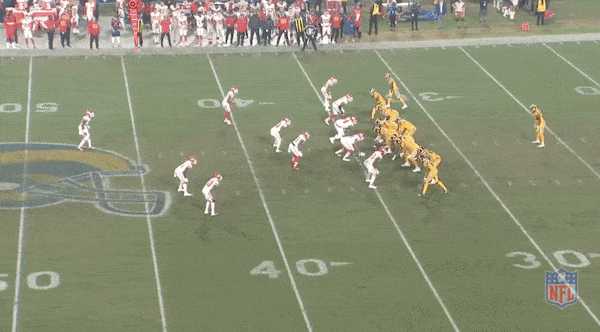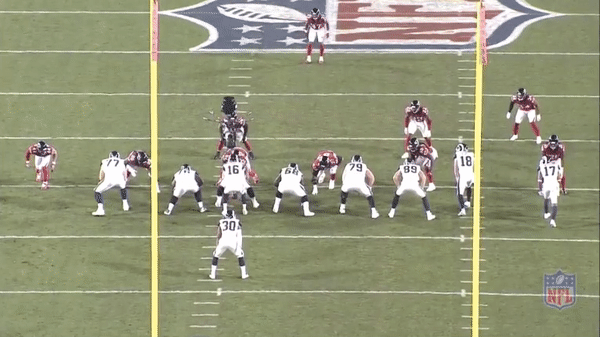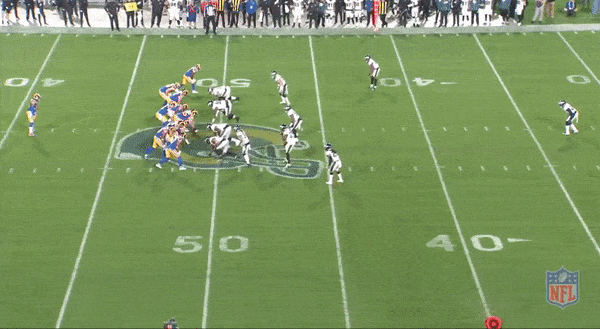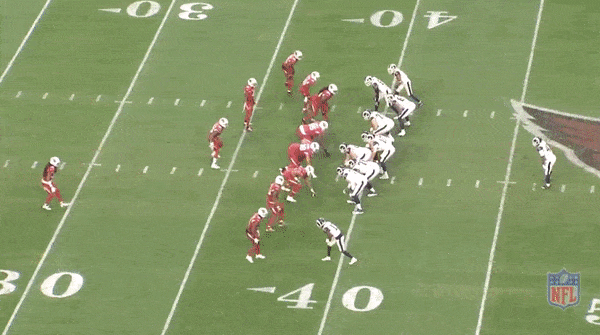The Falcons defense has a specific call for whenever a fast wide receiver lines up in the slot. Anytime that a burner creeps inside, “Speed at three!” echoes throughout the Atlanta secondary. The call is intended to alert the inside linebacker of a potential mismatch — to give him a chance to back up a few steps in coverage while he still can.
For much of his rookie season in 2016, Falcons linebacker Deion Jones responded with a simple, “Thanks.” He appreciated the help. Jones had emerged as a Week 1 starter for Atlanta, and just knowing where to line up was challenging enough for the LSU product during his first few months in the NFL. Over time, though, as Jones’s comfort with the system grew, his response changed. “He’ll bark back every time now,” Falcons linebackers coach Jeff Ulbrich says. “There’s speed at Mike.”
The matter-of-fact retort keeps Atlanta’s defense loose and calms Jones’s teammates’ nerves. It also serves as a tiny dose of affirmation. “I realized that I could run with almost anyone,” Jones says. “If I play my technique right, I can play with any speed.”
Taking Jones in the second round of the 2016 draft was part of Atlanta’s plan to build a high-octane defense. A 222-pound tackling machine who clocked a 4.59-second 40-yard dash at the combine, Jones fit head coach Dan Quinn’s blueprint for constructing a fast-and-furious unit perfectly. Jones’s startling athleticism came into full view as the Falcons defense hit its stride last season, but in 2017 he’s evolved into more than just a fireball.
Over the second half of this campaign, Jones showed that he was operating at a higher plane. He recognized more formations. He predicted more play calls. He sensed more route combinations. An impossibly gifted linebacker married his innate physical traits with heightened awareness, turning Jones into one of the most valuable defenders in football. “Sometimes when Mommy and Daddy give people great genetics, they just rely on that,” Ulbrich says. “When you just rely on pure athleticism, you can only go so far. When you combine elite athleticism — just crazy speed for a linebacker — with anticipation, you get a pretty special product.”
As Jones has leveled up, he’s lifted this defense with him. Atlanta has allowed an average of 16.9 points per game since Thanksgiving. Only one opponent, the Saints, scored more than 21 points against the Falcons during that stretch. With Jones lurking in the middle of the field, Rams star Todd Gurley managed just four catches for 10 yards in the Falcons’ 26–13 wild-card-round victory in Los Angeles. This week, the Falcons travel to Philadelphia to face an Eagles team whose mobile line and stable of backs made a mockery of linebackers all season. They’ll have their hands full with a player who chases down the ball as naturally as most of us breathe.
“He just has a different desire to get to the ball,” Ulbrich says of Jones. “It’s like oxygen. Without it, he’s going to have a problem.”
To trace his progress from his rookie season until now, Jones points to one play in particular. It happened in the fourth quarter of Atlanta’s 22–10 win over the Panthers in Week 17, on a first-and-10 from the Carolina 25-yard line. The Panthers lined up with four pass catchers spread around their formation. At the snap, slot receiver Devin Funchess tore across the field in front of Jones. In this design, Funchess represented little more than a decoy — a shiny object whose goal was to consume Jones’s attention. Yet even as Funchess streaked across the field, Jones barely budged.
The goal of the distraction was to divert Jones from focusing on Panthers tight end Greg Olsen, who was trying to sneak behind him. Instead, Jones drifted directly in front of no. 88, popped the ball in the air, and set up an interception by Falcons safety Keanu Neal.

What’s most remarkable about this play is that Jones never saw where Olsen was going. Look at his head. He was locked onto quarterback Cam Newton the entire time. His movements were based solely on Newton’s eyes and an intuitive sense for where Olsen might be floating. Teams haven’t run this concept against Atlanta much this season, but it was a thorn in Jones’s side as a rookie. “I struggled with that route last year,” he says. “Just not feeling it. I have a way better feel of it now.”
Jones credits that growth to Falcons backup quarterback Matt Schaub, whom he faces most often during practice. There are worse scout-team options than a 14-year veteran with the bag of tricks. “He’s been getting me right, just with that veteran quarterback experience of trying to move people with their eyes,” Jones says.
The pair has talked frequently about the ways in which savvy passers try to manipulate “hook” defenders in the middle of the field. Over the second half of this season, Jones’s reactions to such tactics have become the most ridiculous part of his game: He’s ruining plays that are specifically designed to exploit him.
No offense in the league did a better job of putting defenders in a bind and exploiting their indecision than the Rams in 2017. Head coach Sean McVay’s offense routinely created easy throws with a combination of screens and play fakes aimed at erasing linebackers from the middle of the field. Those plays weren’t available against Atlanta. That’s because Jones can no longer be treated like a typical linebacker.
Take this screen from the Rams’ opening drive in the wild-card matchup. L.A. was lethal on screens this season because it knew how to win the numbers game. It did on this play. But Jones darted around a block and threatened to blow up the screen before Jared Goff even delivered an off-target throw.

Jones also influenced the Rams’ use of play action, even if his impact was quieter. This play from the first quarter is a telling example of what Jones’s blend of athleticism and anticipation can bring. The Rams used a hard play fake going left. Jones initially took a step toward the line of scrimmage before redirecting toward receiver Sammy Watkins running down the middle of the field. With Jones eliminating Watkins — the no. 1 option in a design meant to vacate that area — Goff is forced to check the ball down to Gurley for a negligible gain. Jones’s ability to casually check a speed demon like Watkins isn’t just a pain in the ass for opposing offenses. It alters the complexion of Atlanta’s approach. “In our defense, there are opportunities for wide receivers to get matched up on linebackers,” Ulbrich says. “A lot of times, you try to alleviate that as much as you can and get the best matchups for us. He’s a guy you don’t have to do that for.”

Ulbrich is no stranger to athletically gifted linebackers. The 10-year NFL veteran played alongside Patrick Willis in San Francisco. That doesn’t mean he isn’t sometimes in awe of his 23-year-old pupil. Ulbrich points to a play from late in the fourth quarter of Atlanta’s 20–17 win over the Saints in Week 14, when New Orleans faced a first down from the Falcons’ 11-yard line. Just before the snap, Drew Brees sent wide receiver Willie Snead in motion to the right. Instead of traversing the formation, Snead halted in his tracks, reversed course, and then sprinted back outside. As Brees floated him the ball, Jones showed up to stop Snead cold for no gain. Another play designed to deceive was dead on arrival. “It wasn’t necessarily his coverage responsibility, and all of a sudden, this spider sense went off,” Ulbrich says. “He just knew that he was open and took off out of nowhere to run a wide receiver down. It’s just rare.”

On the next play, Jones hauled in the game-sealing interception.

The moment Snead took off in motion, Jones pointed and began chirping to his teammates. Several of them quickly joined in the chorus. Jones’s burst may be what made him so attractive to the Falcons, but his authority in the middle of this defense is what’s taken Atlanta to within one game of a return trip to the NFC championship. Jones says he could hear his voice get louder before plays around the middle of this season. That confidence has permeated the huddle. “As a defense, we talk about this image we want to put on film,” Jones says. “And I feel like each week, we’ve been getting closer and closer to that. That’s really what we’re all striving for.”
Jones and the Falcons will have their hands full with the Eagles on Saturday. Injured quarterback Carson Wentz may no longer be part of Philly’s game plan, but a mobile, road-grading offensive line and a deep pack of running backs remain. Leading Atlanta’s effort will be a linebacker who’s gone from impressive rookie to legitimate superstar. The scary part, though, is that he might only be scratching the surface. “I don’t think we’ve even seen close to what he can become,” Ulbrich says. “Although he’s gotten better, he can still go to one other place. And he will.”